|
|
Hannibal

|
|
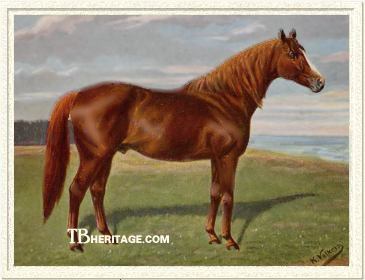 |
|
|
In 1867 the British-bred stallion, Buccaneer was sold to the Hungarian Imperial stud, a transaction soon regretted, when his first few English crops, racing after he was gone, included two classic winners and other good runners. In Hungary he was a blockbuster sire that had a significant influence on central European breeding. Hannibal, Buccaneer's great-grandson, was the third stallion in a line descending from Buccaneer to become a leading sire in Germany, the longest-lived branch of the Sir Paul (1802) line, that traced back to the Byerley Turk.
Hannibal's sire, Trachenberg (1879), was bred by Fürst Herman von Hatzfeld-Trachenberg, a member of the royal family in Prussia whose family had been breeding thoroughbreds as far back as the 1830s; by the 1860s the castle at Trachenberg in Silesia, with its glittering fêtes, musicales (where Franz Liszt would play), grand promenades and stables full of English thoroughbreds was a social magnet for the Prussian aristos.
Trachenberg was by the Buccaneer son, Flibustier (1867). Flibustier's English-bred and German-owned dam, Sweet Katie, had been sent to the Hungarian Imperial Stud at Kisbér to be covered by Buccaneer, but Flibustier was born in Germany, bred by Count Johann Renard, whose Gross Strehlitz estate was in Silesia. Flibustier was the top money-earning racehorse in Germany in 1870, and later, as a stallion for Renard's nephew, Count Mortimer Tschirchsky-Renard, was leading sire in Germany in 1884, 1888 and 1889. Tschirsky-Renard was a principal member of the Northern Germany Breeders Union, and often joined Georg von Lehndorff and Ulrich von Oertzen on trips to England to purchase thoroughbreds for the club.
Trachenberg was out of the mare Dirt Cheap (1860), by Orlando. She had been raced by Baron Nivière in England, running eleven times as a juvenile and winning Lincoln's Brocklesby Stakes (beating eleven), Doncaster's Hopeful Stakes (beating six), and placing second three times, including Liverpool's Mersey Stakes. At age three, unable to go beyond 3/4 of a mile, she won three races in seventeen starts, descending into selling plate level and claimed by C. Rayner in the Manor Plate at Epsom. Dirt Cheap was the kind of mare the German buyers, at that time with very limited funds to spend, were looking for: well-bred, hard-running and inexpensive, and was bought by the German Breeders Society for export. Purchased by von Hatzfeld-Trachenberg at the Society's auction in Germany, she was covered by Flibustier and dropped Trachenberg in 1879.
Trachenberg raced in the colors of Tschirschky-Renard. He was a high-class racehorse, winning six of his eleven races, including the Ratibor-Rennen as a juvenile. At age three, by winning the Henckel-Rennen, the Union-Rennen, the Silberner Schild and the Deutsches Derby (after running a dead heat with the Hungarian horse, Taurus), he was the champion three-year-old in Germany in 1882. As a sire he spent time at Gross Strehlitz and at Baron Ernst von Falkenhausen's stud at Bielau, serving as a stallion for mares owned by members of the breeding society. In 1893 he was leading sire in Germany, with 27 winners of 42 races, led by his son, Hannibal, then a juvenile. Another good one that year was his daughter Karin (1890, out of Flaminia), a winner for von Falkenhausen of the Grosser Sachenpreis and Friedrich Franz-Rennen, and placed in the Preis der Diana. Second four times on the leading sires list, his other significant winners included Rochsburg (1886, winner of the Ratibor-Rennen); Belomantie (1900, Preis der Diana), Rival (1895, Langer Hamburger Ausgleich), Fra Diavolo (1888, Omnium der Steher and other races), Verdruss (1892, winner of the Scandinavian Derby), Nesigode (1891, Jubiläums-Preis at Hoppegarten) and Willis (1895, Jubiläums-Preis at Hoppegarten). Trachenberg was, by this time, the most successful surviving stallion in the Wild Dayrell sire line.
In 1889 Ulrich von Oertzen, representing the Northern German Breeding Society, purchased Zama (1885, out of Sonsie Queen, by Musket), by Hermit, in foal to Crafton, at the Newmarket July sales. Her dam had won the Biennial at Ascot at age three, and she herself, bred and raced by the Duchess of Montrose, was a competetive runner, winning Newmarket's Houghton Stakes in two starts at age two, and placed second in the Ascot Derby in five starts at age three. Brought to Germany, von Oertzen bought her for himself at the Society auction for 500 guineas, and she went to his stud at Remli in Mecklenburg. In 1890 he sent her to Trachenberg, and the following year she dropped the chestnut colt Hannibal. Juba (by Chamant), born in 1892, was her next foal; he won Hoppegarten's Hohenlohe-Oehringen-Rennen. In 1896 she produced Cannae, a sister to Hannibal, and the following year Punis, another sibling, arrived. Punis would win some races for von Oertzen, including the Omnium der Steher at age three, beating twelve others. Cannae would win four of her seven races for von Oertzen, and later produced Saint Cloud (1908, by St. Maclou), a winner of the Peter Handicap, and placed in several other races, and his brother, Scipio Africanus (1910), who won the Grosser Preis von Dortmund and other races.
Hannibal on the Turf
Hannibal was a versatile racehorse that won from six furlongs to 1-3/4 miles in the same season. With the exception of his maiden race at two, he was never worse than second place, winning eight of his twelve starts. As a juvenile he debuted in the Sporn-Rennen, a five furlong race for juveniles, where he placed third. His next race, the Zukunfts-Rennen at Baden-Baden, he was second, with eight in the field. At the Hoppegarten's Renard-Rennen (six furlongs) he won by a length, beating six other youngsters, and at Leipzig he took the Stiftungspreis, beating two.
At age three, 1894, he started at the Hoppegarten in May, where he put away five others over six furlongs by a length in the Oberhof-Rennen. In June he ran in the 11 furlong Jubiläums-Preis at the Hoppegarten, and was second in a field of six, three lengths behind the winner. He was also second in the 6-1/2 furlong Prinz of Wales Preis at Baden-Baden, losing out by a neck, with nine in the field. A month later, although he had given no indication that he could go a distance, he won the Deutsches St. Leger, beating six others over the 1-3/4 miles at Hanover.
Kept in training the next season, he went back to the Hoppegarten to run a second time in the sprint Oberhof-Rennen, winning easily by two lengths. A week later he ran in the Großer Preis von Berlin (1-1/4 miles), winning in a canter by three lengths, and beating seven others. In June at the Hoppegarten he easily won the Jubiläums-Preis (beating four), and at Hamburg took the Großer Hansa-Preis (1-1/4 miles) by five lengths, with four others running. That was his last race.
Hannibal in the Stud
Hannibal retired to von Oertzen's stud at Mecklenburg after the Großer Hansa-Preis, and bred a couple of mares that season; he had two juvenile winners from that first crop of 1896, and for the next two years his winners were bred, owned and raced by von Oertzen. In 1898 Hannibal was purchased for £2,500 by Baron Hermann von Münchhausen, a former Prussian military officer, and went to his stud at Bockstadt. Bockstadt, developed about ten years previously, included a "Scottish-style" castle and princely accomodations for the baron's thoroughbreds. But Hannibal did not stay there long; in 1899 he was bought by the Prussian Government and installed at its principal stud at Graditz, where he spent the rest of his life.
In 1901, when juveniles from Hannibal's first year at Graditz hit the turf, his number of winners and their earnings rose dramatically, from 13 winners of 24 races worth £3,473 in 1900 to 27 winners of 29 races worth £11,181 in 1901 (this included three-year-olds bred by von Oertzen and von Münchhausen). From then on he was among the leading sires in Germany, until he started to physically fail in 1912. He was twice leading sire in Germany, in 1906 (65 races won) and 1912 (44 races won), was second to Saphir in 1907, and second three additional times. He got four winners of the Deutsches Derby, one winner each of the Deutsches St. Leger and Preis der Diana, and quite a few good juveniles. His offspring won at all distances, but seemed more inclined to do best at a 1-1/4 miles or less. He did, however get some horses that won hurdles and steeplechases over four miles.
Hannibal was the third German-bred generation of successful stallions extending back to the English-bred Buccaneer and his sire, Wild Dayrell, but Hannibal's champion son FELS -- the best stallion of his many winning sons -- while better than useful in the stud, did not get a sire son that could continue the line. Two of Hannibal's Derby winning sons -- Arnfried and Sieger -- were retired to the state stud, but they were primarily used on half-bred mares to upgrade remount stock. Hannibal's daughters were successful broodmares that produced several classic winners, and a number of them bred on.
Hannibal's early winners, bred by von Oertzen, included BARKAS (1897, from imp. Galvanic, by Galopin), a winner of the Jubiläums-Preis at the Hoppegarten; LORE (1898, out of Lucia, by Chamant), Hannibal's first classic winner, who took the Preis der Diana for von Oertzen; and OHNESORGE (1898, out of imp. Ordnung by Bend Or), a winner of the Großer Preis von Hamburg at age three. Of these, OHNESORGE successfully bred on. She produced four winners: Olaf (1903, by Sperber's Bruder), a winner of the Goldene Peitsche; Octopus (1909, by Ard Patrick), a not quite top-class three-year-old that placed in several races and won the Klassen Ersatz Preis at age four; Oneida (1916, by Dark Ronald), a winner of the Hertefeld-Rennen, and Orla (1917, by Nuage), who won the Preis der Diana. Orla's female line continued through the 1920s.
Von Oertzen's Chamant mare, Nordlicht (1893) was out of Galvanic (by Galopin), who had produced BARKAS for von Oertzen. He bred Nordlicht to Hannibal after he sold the horse, and she produced several winners for him. First was NORDLANDFAHER (1899), a winner of the Furstenberg Rennen. Then came LICHTBLICK (1900), a winner of the Sierstorpff-Rennen at age two (beating eleven others). She also produced EKLIPTIK (1902), juvenile winner of the Stuten-Biennial at the Hoppegarten; EKLIPTIK was sent over fences later in her career, winning Hamburg's Kaiserin Auguste Victoria-Jagd-Rennen in 1907 and placing second in Berlin's Grosser Preis von Karlshorst and third in the Vierzehnte Berliner Internationale Steeple-Chase (Berlin).
Von Oertzen also bred MYRITZ, (1901, from Meisterin), a winner of the Hamburger Criterium and placed second in the Sierstorpff-Rennen at age two, and third in the Preis der Diana (won by Lucca) at age three.
|
| 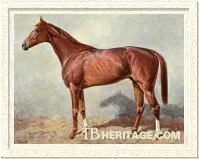
Hamilkar
|
|
HAMILKAR (1899, out of imp. Highland Queen by Highland Chief), bred by von Münchhausen at Bockstadt, was in Hannibal's fourth crop, and one of his best early runners. A well-muscled chestnut, he first ran for Kurt von Tepper-Laski (more a steeplechaser owner than a flat racing supporter), and at age two won the Ratibor Rennen, beating twelve other youngsters. He was sold to Felix Simon, a wealthy Berlin-based sportsman whose early racing interest focused primarily on steeplechasing, where his horses ran under his nom-de-course "Captain Joe." As he moved into flat racing, Simon gradually dropped the "Captain Joe." Simon was also a competitive sport sailor and early automobile enthusiast.
|
At age three HAMILKAR was unbeaten, winning six races, including Breslau's Preis von Schleslen, the Herzog Carl-Eduard-Rennen, the Hertefeld-Rennen at the Hoppegarten, and the Deutsches St. Leger, making him Hannibal's second classic winner. The next year his wins included the Herzog von Ratibor-Erinnerungs-Rennen at Breslau (beating three), and the Preis von Donaueschingen. He was used as a sire of half-breds; one of his sons, Hammerschlag (1910, out of an ango-arabian mare Ideal) was used as a stallion at the state stud at Hanover.
Simon also owned and raced IRMIN (1899), out of Ilse, by Saraband. Ilse was a superior race mare that had been at the top of the earnings list in Germany in both 1893 and 1894, owned by von Münchhausen. IRMIN wasn't quite that good, but at age five he was second in Hoppegarten's Jubiläums-Preis (1-3/8 miles) to Waldfee, and in the fall won the Wilamowitz-Zucht-Rennen (1-1/2 miles) at the Hoppegarten.
KOLIBRI (out of Katy (a half-sister to Ilse), by Chamant), also in the 1899 Bockstadt crop and raced by von Münchhausen, won the Hoppegartener Jubiläums-Preis in 1902, beating eight others, but that was his only big win. SIROCCO (out of imp. Mrs. Stirling by Sterling), also born in 1899, ran for Count J. Siestorpff. As a juvenile he won the Preis des Winterfavoriten (equivalent of England's Middle Park Plate), in 1903 he also took the Jubiläums-Preis at Hoppegarten, and the next year he won the Grosses Berliner Handicap (1-1/4 miles), beating ten, which included the good horses Granit and Fedor. Another 1899 foal, the gelded MANDARIN (1899, out of Minze) was the first Hannibal to win over fences, taking the Neusser Jagd-Rennen (3-1/4 miles) in 1904, and placing in several good chases.
Hannibal's first crop bred by the state stud, and born in 1902, included PHOSPHOR (out of Santa Palma), a winner of the Sachen Weimar-Rennen, SAHARA (from Sapristi, by Bandit), a winner at ages two and three, and GANGES. GANGES (out of Glenayes, by Galopin), a brown colt trained by Richard Waugh at Graditz, was a pretty good juvenile that took the Jugend-Rennen at Dresden, beating six, and the Preis des Winterfavoriten (at Köln), beating six, and placing third in two other races. At age three he won the Grosser Preis von Hannover, among other races, and was second to Farandole (by Saphir) in the Hertefeld-Rennen and to Normanne (by Saphir) in the Germania-Preis. GANGES' sister, GALAOPER (1903) established a long-lived tail-female line in Germany still producing winners.
Festa, a small mare in foal to Ayrshire, was purchased for £1,000 by van Oertzen, representing the German breeding society, at the 1901 Newmarket sales. Out of Epsom Oaks winner L'Abbesse de Jourrare, and by the great St. Simon, Festa had won 2-1/2 minor races in twenty-two starts. Her full brother, Desmond, had been a successful juvenile winner and was standing at the Fort Union Stud, in Ireland, of his owner-breeder, Lord Dunraven, but his first foals were born in 1901, and no one knew then what a good stallion he would become. When she got to Germany, Festa was auctioned off for £500 to Arthur Weinberg. At his Gestüt Waldfried, near Frankfurt-am-Main, she produced a succession of outstanding racehorses that included three good sire sons and an excellent producing daughter. Two of these -- FELS (1903) and FABULA (1904) -- were by Hannibal.
|
| 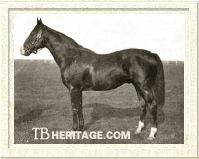
Fels
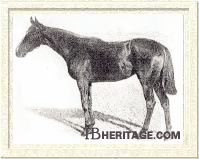
Fabula
|
|
FELS, by far the best racehorse Hannibal ever got, was the top earning racehorse in Germany in three successive years, 1905-1907, an exceptionally good juvenile and a classic winner at age three. At Gestüt Verwaltung, he was among the leading sires in Germany throughout his stud career, always in the top ten, and usually placing fourth or fifth in the standings (third in 1924), getting speedy horses that could extend to classic distances.
He got several classic winners, including Deutsches St. Leger winner Ossian (1918), champion racehorse in 1921 for Gestüt Waldfried and later a sire of classic winners in Czechoslovakia. FELS' son Harlekin (1914), a good winner in Germany, was leading sire in Poland in 1928 and 1934. Another FELS son, Laland (1917), got four classic winners in Germany, including the great filly Nereide, the leading earner on the flat in 1936 in Germany, and later dam of Nordlicht, who won both the Austrian and German derbies. Laland was the the last good stallion in the Wild Dayrell sire line.
FELS' sister, FABULA, bred at Gestüt Waldfried, won eleven of her sixteen starts betwen the ages of two and four, among them the Zukunfts-Rennen, the Austria Preis and the Golden-Peitsche.
|
FABULA produced Fabella (1910, by Spearmint), a winner of the Preis des Winterfavoriten at two and other races through age four, and Favilla (1912, by leading sire Nuage) that later produced two classic winners, Favor and Faustina (both by leading sire Fervor, and so in-bred to Festa). Favor was a useful stallion, and Faustina continued the tail-female line, which is still throwing out winners today.
FLORIDA (1903, out of Franche Comte, by Saxifrage), was another product from Gestüt Waldfried; her dam, Franche Comte was a foundation mare at the stud; the grand German runner of the 1920s, Ferro, descended tail-female from Franche Comte. FLORIDA won the Schwarzwald-Rennen at Baden-Baden at age three. Another Weinberg stud winner by Hannibal was RUBICA (1905, out of Rupie), who took the Sporn-Rennen as a juvenile and was second to SIEGER in the Hamburger Criterium, and at age three second to FABULA for the Goldene Peitsche.
JAUCHZER (1903, out of Jolly Boat, by Panzerschiff), bred at Graditz, was a high-class runner for the state stud. He won the Grosser Preis von Hannover (1-1/2 miles) in both 1906 and 1907, and also won Breslau's Herzog von Ratibor-Erinnerungs-Rennen (1-3/4 miles).
SIEGER (1905, out of Semiramis, by Dorn) was bred by Alfred von Oppenheim at Gestüt Schlenderhan, near Cologne, that had been established by his father, Eduard. His dam, Semiramis, was a half-sister to Schlenderhan's great stallion, Saphir; she was by Dorn, the champion German runner of 1892, and she had won four minor races in fifteen starts at ages two and three. As a Schlenderhan broodmare Semiramis produced nine winners, including SIEGER and KRIEGSGÖTTIN.
As a juvenile SIEGER'S wins included the Sierstorpff-Memorial (Hoppegarten), beating nine others, the Hamburger Criterium, beating six (with RUBICA second), Breslau's Graf Johannes Renard-Erinnerungs-Rennen, beating four, and Köln's Rheinisches Zucht-Rennen; he tailed off in the fall, placing third to Blaustrumpf in the Falkenhausen-Memoria at the Hoppegarten, but was the top of his generation. The next year he started well by winning the Frühjahrs-Preis, but could only run second to Südring in the Silberner Schild, and was twice second to Horizon II, in the Henckel-Rennen and the Großer Hansa-Preis (Hamburg) in small fields before he won the Deutsches Derby (with Horizon II second, and four others in the field). After that, he failed to place or win in any races. It was Arthur Weinberg's Faust that won champion honors that year. SIEGER was sold to the state stud, and was used as an improvement stallion at one of its depots.
Another Hannibal-Semiramis foal, KRIEGSGÖTTIN (1911) won the Grosser Preis von Hannover (5.5 furlongs) and Hamburg's Hammonia-Preis, and was third in Baden-Baden's Zukunfts-Rennen as a juvenile; she later produced Kronos (1923, by Prunus), a winner of Hamburg's Espoir-Ausgleich at age three, but her line did not continue. It was her sister, SALAMIS (1910), that proved the better broodmare, producing Saturn (1922, by Ariel), a winner of several races for Gestüt Schlenderhan, and his sister Athene (1916, winner of the Fabien-Preis). Athene was a superior matron at Schlenderhan, second dam of the top runner Athanasius (1931, by Ferro) and of Agalire (1931, winner of the Grosser Preis von Baden, by Laland) and her sister Adlerfee (1935, winner of the Preis der Diana, by Ferro). Many high-class winners in Germany and France descend in tail-female from Athene. Seele (1920), a third sibling from the SALAMIS-Ariel cross, also bred on, with classic winners Sommerblume (1956) and Sudan (1959) among her descendants.
|
| 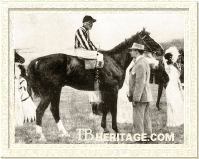
Arnfried
|
|
ARNFRIED (1906, out of Abendglocke, by Chamant), was bred and raced by the state stud at Graditz. His dam, Abendglocke, was out of Autonomy (1884), an Isonomy daughter that had been purchased in England for Graditz, and was a productive foundation mare for the state stud. ARNFRIED was a useful juvenile that won the Oktober-Preis für Zweijährge, but could only run second to Fervor (Galtee More, out of Festa) in the Preis des Winterfavoriten. At age three he won the Deutsches Derby, and placed in several other important races, including second to For Ever (by Saphir) in the Großer Hansa-Preis, but was not the best of his generation. He was used primarily to get half-breds remounts at the state stud at Hanover. Several of his daughters are seen in Hanoverian pedigrees.
|
ARNFRIED'S sister, ABENDLUFT (1907), was a good sprinter. She reeled off wins in four races at age three: the Goldene Peitsche (3/4 miles), the Preis von Rhein (1 mile, at Köln), the Kincsem-Rennen (3/4 miles, at Baden-Baden), and the Oppenheim-Memorial (3/4 miles, at Grunewald).
Ameise (1898, by Matchbox), a half-sister to Abendglocke, produced ACROPOLIS (1911, by Hannibal), later the dam of Alamund (1917, by Laulon), a winner of the Großer Hansa-Preis at age three.
|
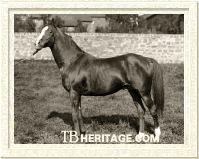
Gulliver
|
|
GULLIVER II (1909, out of Gnädigste, by Escogriffe), was Hannibal's last Deutsches Derby winner. Another big blaze-faced chestnut, he was bred at Graditz, as was his sister GLOSSE (1913). He won seven of his ten starts at ages two and three, and, like all Graditz runners of this period, was trained by Reggie Day. His best effort as a juvenile was second in the Preis der Winterfavoriten, where he ran second to Dolomit. At age three his wins included the Großer Preis von Hamburg (1-3/8 miles, beating eight by 1-1/2 lengths), the Silberner Schild (1-1/2 miles), Hamburg's Großer Hansa-Preis (1-3/8 miles, by 3/4 of a length, beating six), and the Deutsches Derby (beating seven), a brilliant season that made him champion runner in Germany in 1912.
|
GULLIVER was first a stallion at Graditz, where he got some winners --he was tenth on the leading sires list in 1921 and 1924, and his progeny won a total of 845 races (on the flat and over fences). In 1921 he went to the Union Gestüt Berlin at Mansbach, where he died in 1932.
GULLIVER'S best flat runner was probably the filly Ostermädel (1929, out of Taiga), who won the Fürstenberg-Rennen at Baden-Baden, and placed third to Faienza in the Preis der Diana. Other winners on the flat included Prämie (1917, out of Deutsches Derby winner Pontresina by Biniou), winner of Berlin's Sporn-Rennen at age two and Danubia-Rennen (1-1/4 miles) at age three; Eigilolf (1921, out of Eiderduck), who won the Zuchtrennen / München (1-1/2 miles); HANS GUNTHER (1922, out of Halbronnette, by St. Damien), a winner of Düsseldorf's Rheingold-Pokal (1-1/4 miles), and Taugenichts (1920, from Tautropfen), who ran to age six, his best win Baden-Baden's Oos-Ausgleich (1-1/2 miles).
GULLIVER was a better sire of jumpers than of flat runners, especially after he went to the Union Gestüt Berlin. His most notable winners over fences included Primadonna (1918, out of Praxedis by Ayrshire), who beat ten others in the Großer Preis von Grunewald; Rheinland (1922, out of Atina), winner of the Berolina Jagdrennen; Palamon (1921, out of Patschuli), a winner of the Berlin (Karlshorst) Orcadian-Jagdrennen; Fritz Fromm (1923, out of Felicitas), who took Hamburg's Erinnerungs-Jagdrennen and placed in numerous other good chases; Kikeriki II (a winner of the Berlin (Grunewald) Internationales Hürdenrennen; and the gelded Parsifal (1922, out of Partitur), whose wins included the Grosser Preis von Grunewald and the Metropole-Preis (Grunewald).
GULLIVER'S sister, GLOSSE, bred some winners, including Grossinquisitor (1922, by Anschluss), a sprinting winner of the Ulrich von Oertezen-Rennen, the Batschari-Erinnerungsre, the Goldene Peitsche, and the Hoppegartener Ehrenpreis. His half-sister, Gunda (1932, by Herold), was second dam of Charkow (1950), a good winner in the Soviet Union.
FLAGGE (1909, out of Fama, by Saraband) and GRITA (1909, from Generalin, by Habenichts), were both bred and raced by Graditz, which, with their additions to GULLIVER'S successes, had a very good season in 1912, culminating with Hannibal's premiership among stallions that year. GRITA'S dam, Generalin, was a half-sister to GULLIVER, and descended from the imported King Tom mare, Gorse, the source of many high-class runners in Germany. GRITA's wins included the Galtee More-Rennen at Hoppegarten and the Kincsem-Rennen at Baden-Baden at age two, and the Hammonia-Preis at Hamburg at age three. As a broodmare at Graditz she produced several winners: Gralsritter (1922, by Nuage), who took the Hamburger Criterium as a juvenile and the Fervor-Rennen at Berlin (Grunewald) at age three, and his half-sister, Gänseblume (1915, by Ard Patrick), a winner of the Preis der Stadt at Hannover and other races; Gänseblume's female line continued through the mid-twentieth century. GRITA also produced Geiser (1918, by Nuage), who ran in top company, and was second in the Grosser Preis von Baden to Ossian.
FLAGGE was a good juvenile whose wins included the Landgrafen-Rennen at Frankfurt and the Hoppegarten's Stuten-Biennial, and she placed second to the French-owned Quai des Fleurs in the Zukunfts-Rennen at Baden-Baden. In 1912, at age three, she won the Henckel-Rennen (Two Thousand Guineas), the Goldene Peitsche, and the Großer Preis von Magdeburg, placing second to Einsicht in the Preis der Diana, and third to GRITA and Fürge in the Hammonia-Preis at Hamburg. She later produced Freibeuter (1918, by Dark Ronald), a winner of Dortmund's Klönne-Rennen and some other races. Her sister, FABEL II (1912) became the dam of Flüchtling (1918, by Fervor), a winner of the Preis von Schleisien in both 1921 and 1922.
Hannibal's other winners included the good juveniles DIETRICH VON BERN (1903, Dumiduca, by Isonomy), winner of the Renard-Rennen; CATHAGO (1907, from Carrara, by Childwick), who took the Stuten-Biennal at Hoppegarten; HORNIST (1907, out of Hortensia, by Ayrshire), won took the Leipziger Stiftungs-Preis. Other winners included LITTORAL (1907, out of Liberality), who placed several times on the flat and later won over fences, including the Haupt-Hürden-Rennen at Berlin at age three; MONDSTEIN (1908, from Mosul, by Bona Vista), who won the Landgrafen-Rennen at age two and the Union-Rennen at age three, and his sister MAUSEFALLE (1906), who won the 2200 meter Friedrich Franz-Rennen, and a number of other useful handicappers.
Some Broodmare Daughters
In addition to previously mentioned fillies that became good broodmares, Hannibal's productive daughters also included:
ABWECHSLUNG (1909, out of Alveole, by Crafton), bred at Graditz, won five and placed four times in nine starts, including the Oppenheim Memorial at two, and the Eingracht-Rennen, Preis von Hanover, and Stuten-Biennial at three. She produced three winners, including Abgott (1919, by Biniou), a winner of the Deutsches St. Leger, Grosser Hansa Preis and Herzog von Ratibor-Erinnerungs-Rennen at Breslau.
MENTON (1911, from Menippe by Orion), was a juvenile winner of the Rheinland-Preis, and at age three the Fervor-Rennen (7 furlongs). She later bred Piemont (1925, by Famulus), a useful winner at age three of the Nickel-Rennen, Preis von Mülheim, and Großer Preis von Düsseldorf. Her female line eventually went to Poland, where there were some winners.
BRACING AIR (1911, out of Mariposa, by Martagon), a sprinter, ran for two seasons, placing numerous times, including second in the Germania-Preis as a juvenile, and second in the Preis der Stadt at Hannover at age three. She produced Bafur (1921, by Fervor) a sprinting winner of the Landgrafen-Rennen Gestüt Weil at age two, of the Golden Peitsche (3/4 miles) at age three, and the Fervor-Rennen (3/4 miles) at age five. BRACING AIR was also the dam of Burgbrohl (1924, by Arranmore), a winner of the Kisasszony-Rennen (1 mile) at age three.
LUX (1915, out of Lanze, by Ard Patrick), a broodmare for the Sklareck brothers, produced Lupus (1925, by Herold), the champion of his generation at three (although not a patch on the year-older Oleander for earnings), who won five races at age three, including the Union-Rennen, Deutsches Derby, Kartellrennen der Dreijährigen, and Deutsches St. Leger. Lupus later got some winners, mostly stayers and jumpers, including Friedrich (1938), whose wins included Dormund's Kartellrennen der Dreijährigen (1-1/2 miles), Krefeld's Preis der Rheinprovinz (1-1/2 miles), and Köln's Rudolf-Rose Rennen; his gelded son, Mustafa (1935) was good over fences, winning Karlshort's (Berlin) Hauptjadrennen der Vierjährigen and Großer Preis von Karlshorst. LUX also produced Labrador (1921, by Robert le Diable), a winner over fences of the Grosses Hürdenrennen in both 1925 and 1926.
EILPOST (1915), who at age three ran second in the Preis der Stadt Hannover and the Stuten-Biennal, and placed well in some other races, was the dam of Postmeister (1925, by Pergolese), a winner of the Landgrafen-Rennen at Frankfurt, and second in the Henckel Rennen.
Hannibal, who "suffered from paralysis" for some time, was destroyed on February 4, 1915. His skeleton was sent to the Natural History Museum at Frankfort-um-Maine.
--Patricia Erigero |
|
|
|

